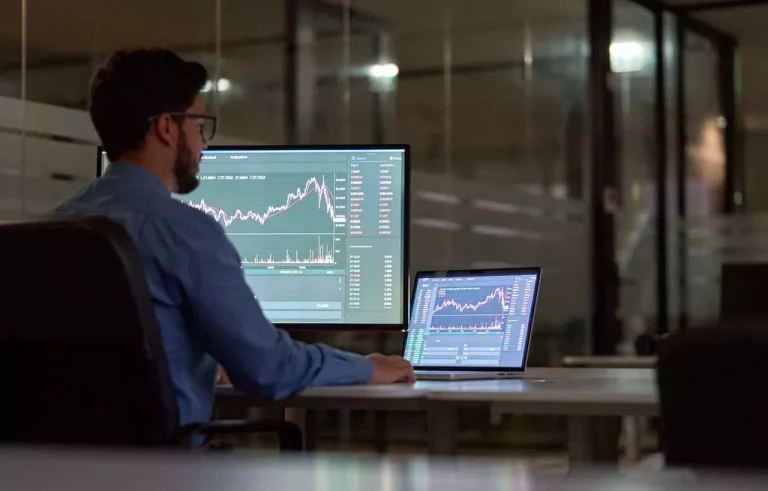This info can help traders develop subtle trading methods and make knowledgeable choices. Typically, giant institutions trade “off” the traditional exchanges in Dark Pools as a method to hold the transaction non-public, or keep away from inflicting vital volatility within the markets when they’re making big trades. It’s harder to “move the market” when the trades are hidden, and these firms can save big time on transaction fees by trading by way of a Dark Pool. Dark Pools work by matching buyers and sellers anonymously and executing trades outside of public exchanges. However, dark swimming pools even have drawbacks, together with a scarcity of transparency, potential for insider buying and selling, and reduced value discovery. The SEC requires darkish swimming pools to register as various buying and selling techniques (ATSs) and adjust to a range of laws designed to protect investors and ensure market integrity.

Blackbox Trading System – Options
- Living as much as their “dark” name, these swimming pools haven’t any public transparency by design.
- This work finds that prime ranges of volatility on lit exchanges are linked to an economically vital lack of market share by dark pools to lit exchanges, as predicted by theory.
- A darkish lit pool is a private change the place the main points of the transactions aren’t out there to the public, however the pool is still regulated by securities legal guidelines and required to report buying and selling activity to the related authorities.
- They act as a neutral third party, matching buyers and sellers with out having a stake in the trades.
In actuality, and primarily based on rising analysis evidence, the results of darkish buying and selling on the quality of markets – the options that indicate how properly they are functioning – are contextual. Regulations such as the European Union’s Markets in Financial Instruments Directive II (MiFID II) goal to boost transparency by imposing stricter reporting requirements. These guidelines attempt to balance the privacy wanted for big trades with the market’s demand for well timed information, in the end influencing volatility dynamics.
With the arrival of supercomputers capable of executing algorithmic-based packages over the course of just milliseconds, high-frequency buying and selling (HFT) has come to dominate daily buying and selling volume. HFT expertise permits institutional traders to execute their orders of multimillion-share blocks ahead of different buyers, capitalizing on fractional upticks or downticks in share prices. When subsequent orders are executed, profits are instantly obtained by HFT merchants who then shut out their positions. This type of legal piracy can happen dozens of occasions a day, reaping large gains for HFT traders. One of the first benefits of dark pools is that they reduce market influence, which means that the execution of a large trade does not significantly affect the worth of the safety being traded.

Who Runs Darkish Pools?
This improves execution quality for institutional traders by lowering market influence costs. However, the lack of pre-trade transparency can result in information asymmetry, the place some participants achieve a bonus over others. To avoid the transparency of public exchanges and ensure liquidity for large block trades, a quantity of of the funding banks established non-public exchanges, which came to be often recognized as dark pools. For merchants with giant orders who’re unable to place them on the public exchanges, or wish to avoid telegraphing their intent, darkish swimming pools present a market of patrons and sellers with the liquidity to execute the trade.
Dark pools offer a lens into investor sentiment, notably among institutional gamers. These venues can mirror confidence or caution in the market, especially during times of uncertainty. Bullish sentiment usually corresponds to elevated shopping for exercise within darkish pools https://www.xcritical.com/, whereas bearish sentiment could manifest as heightened promoting to mitigate danger.
Because of their sinister name and lack of transparency, dark pools are often thought-about by the public to be doubtful enterprises. However, there’s a real concern that due to the sheer volume of trades conducted on darkish markets, the common public values of certain securities are increasingly unreliable or inaccurate. There is also mounting concern that dark pool exchanges provide glorious fodder for predatory high-frequency trading. Dark pools offer institutional investors a range of benefits, including reduced market impression, elevated anonymity, entry to liquidity, and decrease transaction prices. Since the details of the trades usually are not out there to the public, it can be challenging to assess the impression of dark pool trading on the broader market. Australian and Canadian regulators have also introduced measures to minimize back the amount of transactions executed in darkish venues.
Can Retail Traders Use Darkish Pools?
By understanding dark pool buying and selling and day buying and selling influence, traders can make more knowledgeable selections and mitigate the dangers of sudden value shocks. Large orders placed by institutional merchants affect the provision and demand of property. However, the influence just isn’t Initial exchange offering readily visible as different traders within the public market are not prone to see it.

While it’s unclear how this situation will in the end dark pool activity unfold, these current developments suggest that the semiconductor area could turn into a very energetic space for merchants in the near-term. DPD measures the quantity of orders that are resting in a darkish pool at a given price stage. Dark Pool Indicators are instruments used to achieve a deeper and extra insightful perspective into buying and selling activity exterior of the open market. Intrinio also presents some of the finest support within the monetary information trade.
The lack of transparency in the dark pool can make it troublesome for buyers to gauge the market’s course and make informed trading decisions. Given that the dark pool was primarily created to prevent large orders by institutional merchants from affecting the basic public market, you can be sure it impacts it significantly lower than the media would need to paint it. The laws governing darkish pools differ depending on the jurisdiction by which they function.
A darkish pool is a private trade where buyers and sellers can commerce securities, usually shares or bonds, anonymously, with out disclosing their identification or the details of the transactions. Based on the evidence from recent studies (for example, Ibikunle and Rzayev, 2022), the aim of these efforts is furthered by dark swimming pools working alongside lit exchanges. It is essential that policy-makers are cautious to not remove the advantages of darkish trading for market high quality by arbitrarily imposing restrictions on it. Research exhibits that volatility is a critical driver of the general dynamics of self-selection into dark and lit venues for buying and selling (Zhu, 2014).
It is difficult to say exactly how many dark swimming pools are currently working in the U.S., as the quantity may fluctuate over time. However, there are prone to be several dozen dark swimming pools presently active within the country. This is the distinction between the variety of purchase and promote orders within a darkish pool. A massive imbalance in favor of buy orders, for example, might signify sturdy demand for a particular safety and that its price is more doubtless to rise. Institutional buyers use dark Pools to get their orders stuffed without impacting the public market.
